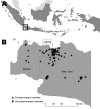Environmental sampling for avian influenza virus A (H5N1) in live-bird markets, Indonesia
- PMID: 21122218
- PMCID: PMC3294595
- DOI: 10.3201/eid1612.100402
Environmental sampling for avian influenza virus A (H5N1) in live-bird markets, Indonesia
Erratum in
- Emerg Infect Dis. 2013 May;19(5):841. Indryani, Sri [corrected to Irianti, Sri]
Abstract
To identify environmental sites commonly contaminated by avian influenza virus A (H5N1) in live-bird markets in Indonesia, we investigated 83 markets in 3 provinces in Indonesia. At each market, samples were collected from up to 27 poultry-related sites to assess the extent of contamination. Samples were tested by using real-time reverse transcription-PCR and virus isolation. A questionnaire was used to ascertain types of birds in the market, general infrastructure, and work practices. Thirty-nine (47%) markets showed contamination with avian influenza virus in ≥ 1 of the sites sampled. Risk factors were slaughtering birds in the market and being located in West Java province. Protective factors included daily removal of waste and zoning that segregated poultry-related work flow areas. These results can aid in the design of evidence-based programs concerning environmental sanitation, food safety, and surveillance to reduce the risk for avian influenza virus A (H5N1) transmission in live-bird markets.
Figures
References
-
- World Health Organization. A guide to healthy food markets. Guidelines. Geneva: The Organization; 2006.
Publication types
MeSH terms
Grants and funding
LinkOut - more resources
Full Text Sources
Medical

